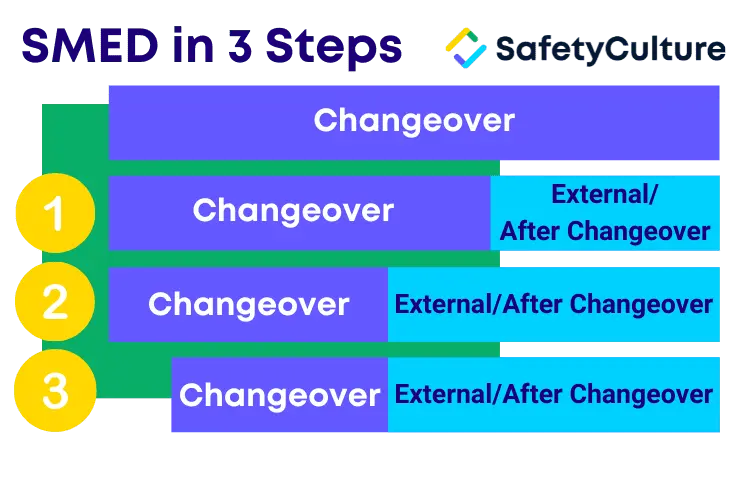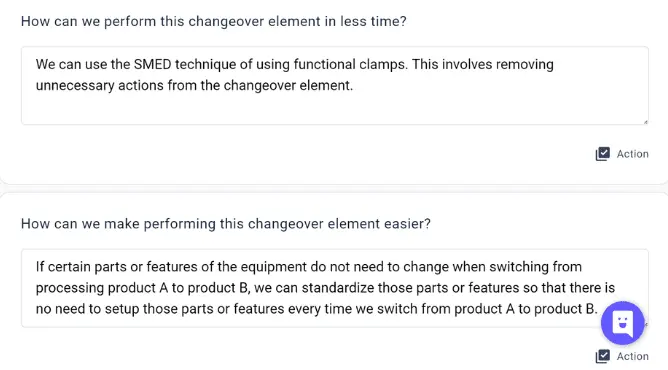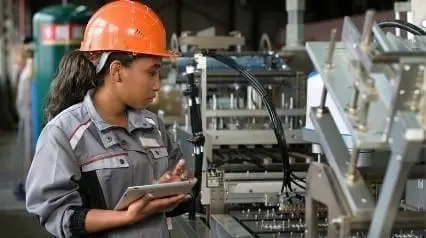What is SMED?
SMED, or Single-Minute Exchange of Die, is a Lean tool used in manufacturing to reduce equipment changeover time. The goal of SMED is to complete as many steps as possible while the equipment is running (or processing), to save time and quickly change over to processing the next product.
Single-Minute Exchange of Dies (SMED) Meaning
Before learning more about this time-saving tool, it’s necessary to understand what each term of the acronym means. The last letter, D, stands for dies/die. In manufacturing, a die is a specialized piece of equipment used to define the size and shape of a product. A die is best described as a stamp or an industrial cookie-cutter.
Moving on to the second-to-last letter, E stands for exchange of dies. Since a die is customized to create a certain size and shape, the die of one product would be different from the die of another. Therefore, exchanging dies simply means switching from making one product to making another.
The remaining two letters, SM, stand for single-minute, which is ideally how long it should take to switch from making one product to another or “to exchange dies”. However, this can be modified to mean single-digit minute exchange of dies (less than 10 minutes exchange of dies).
SMED and Equipment Changeover Time
Now that the exact meaning of SMED has been discussed, another thing to clarify before considering SMED is how it’s related to equipment changeover time. Changeover is the transitioning of equipment from processing one product to processing another. It’s very similar to the exchange of dies (defined in the previous section).
An interesting thing about SMED is that what it stands for (single-digit minute exchange of dies) describes the intended result of using SMED more so than the actual process of how to make the exchange of dies take less than 10 minutes (or of how to reduce equipment changeover time to less than 10 minutes).
Do You Need SMED?
Before going into the benefits of SMED or why manufacturers use it, it may be helpful to ask if SMED can be applied to your production process and if it’s the right Lean tool to use for making improvements. The following are factors you need to consider before implementing SMED:
- Do you have a system in place for measuring manufacturing performance data?
If you don’t have a system, consider using SafetyCulture (formerly iAuditor), a powerful inspection platform built for teams and used by industry leaders. - Does the system measure Overall Equipment Effectiveness (OEE)?
OEE is a manufacturing industry gold standard for spotting inefficiencies of equipment and of production processes involving it. OEE looks at 3 factors (availability, performance, quality) and calculates the score of each factor, with the combined score being the OEE score. - Do you have at least 2 weeks worth of manufacturing performance data collected from the system?
- Based on the data, what percentage of lost productive time is from changeovers?
To help determine this, it’s recommended to take a closer look at the breakdown of the availability score, as seen in the example provided by IndustryWeek below:Availability score = Available time ÷ Scheduled time Available time: Scheduled time: Downtime (Lost Productive Time): Scheduled time
– DowntimeGross available time
– Planned downtime+Breakdowns
+Setups and adjustments
+Minor stoppagesChangeovers are known to add to setups and adjustments (planned downtime), one of the Six Big Losses that negatively impact manufacturing productivity.
- Is the percentage of lost productive time from changeovers 20% or above?
If the percentage is less than 20%, a Total Productive Maintenance (TPM) program is recommended, instead of SMED. - Do you have equipment that (a) employees are familiar with and (b) that is a constraint?
- Is the changeover of this equipment (c) performed more than once each week, (d) takes an hour or so to complete on average, (e) but can sometimes take much longer to complete (such as 2 hours more)?
- Inventory control?
If you have answered yes to the questions above, you can begin implementing SMED on the equipment changeover.
What You Can Gain From Implementing SMED
The main benefit of implementing SMED is reduced equipment changeover time, which creates a positive domino effect on other aspects of production. The five key benefits are:
- Increased capacity / machine work rates
- Equipment changeovers completed more often
- Reduced batch sizes / smaller lot sizes
- Reduced stock holdings / lower inventory levels
- Less space and handling required
- Increased flexibility to address customer needs
- Less waste produced
- Standardized changeover procedures
- Less room for errors / improved quality
- Fewer defects produced
- Improved safety and consistency
- Lower production cost due to less planned downtime
Achieve operational excellence
Cultivate a culture of excellence with our digital solutions that enhance efficiency, agility, and continuous improvement across all operations.
Explore nowSimplified SMED Process

SMED | SafetyCulture
To help you get started with implementing SMED, here’s a quick 3-step guide on the SMED process.
Step 1: Separate
The first step in the SMED process is to separate changeover elements or group them according to their type (internal or external). Changeover elements are the steps taken to complete the equipment changeover. There are two types of changeover elements:
- Internal changeover elements are the steps that can only be done when the equipment is not processing anything
- External changeover elements are the steps that can be done while the equipment is running (or in the middle of processing something)
Identifying the type of changeover element is important because making as many steps (or changeover elements) external is how SMED reduces equipment changeover time.

Separate Changeover Elements in the SafetyCulture SMED Template
Step 2: Convert
The second step in the SMED process is to convert internal changeover elements to external changeover elements. Once you’ve identified an internal changeover element that could be converted to external, ensure that the benefit (in terms of time saved) outweighs the cost of conversion (the resources needed to convert the changeover element to external).

Convert Changeover Elements in the SafetyCulture SMED Template
A SMED technique for converting internal changeover elements to external ones is to use intermediate or duplicate jigs. The next product can be prepared using a jig (a kind of framework or mold) while the first product is being processed. The jig containing the prepared next product is then simply attached to the equipment.
Step 3: Streamline
The third step in the SMED process is to streamline the internal changeover elements that weren’t converted to external. The fundamental SMED technique for this step is to follow the Lean principle of “trimming the fat” by removing inefficiencies from internal changeover elements. Simple and effective SMED techniques for this include the following:
- Try the 5S Lean method
– organize the work area for maximum efficiency - Use functional clamps
– reduce the number of actions to only what is necessary - Standardize parts or features
– make performing internal changeover elements easier - Eliminate adjustments
– calibrate equipment to transition quicker
– use standardized settings and fixed guides

Streamline Changeover Elements in the SafetyCulture SMED Template
Create Your Own SMED Template
Eliminate manual tasks and streamline your operations.
Get started for FREESMED Examples
To give you a better idea of how the SMED process fits in your workplace or business, here are 4 SMED examples which show that it can be used even in industries outside of manufacturing:
SMED Examples for Restaurants:
| SMED Example 1 | ||
| Changeover | Switching from lunch to dinner | |
| Equipment | Kitchen and staff | |
| Time Equipment is Running | when guests are being served | |
| Time Equipment is Stopped | when the restaurant is closed | |
| Elements: | ||
| bring out ingredients for dinner menu meals | clean the kitchen / prepare stations (throwing out oil, clearing chopping boards, etc.) | ensure second shift (or dinner shift) servers are ready |
| Step 1: Separate | ||
| Internal | External | |
|
|
|
| Step 2: Convert | ||
| Internal | External | |
|
|
|
| Step 3: Streamline | ||
| Internal Streamlined | optimized kitchen preparation and cleaning flow | |
| SMED Technique | using 5S Lean method to organize the kitchen | |
| SMED Example 2 | ||
| Changeover | Preparing meal A to preparing meal B | |
| Equipment | Cooking tools and ingredients | |
| Time Equipment is Running | stove is on / chef is cooking | |
| Time Equipment is Stopped | stove is off / chef is not cooking | |
| Elements: | ||
| moving to pantry to get ingredients for meal B | looking for cooking tools to use for meal B | prepping cooking tools for use (preheating, etc.) |
| Step 1: Separate | ||
| Internal | External | |
|
|
|
| Step 2: Convert | ||
| Internal | External | |
|
|
|
| Step 3: Streamline | ||
| Internal Streamlined | meal B ingredients are placed near the cooking station | |
| SMED Technique | use functional clamps | |
SMED Examples for Hospitals:
| SMED Example 3 | ||
| Changeover | Operating room and patient room/bed turnover | |
| Equipment | Operating room and patient room/bed | |
| Time Equipment is Running | when operating room or patient room/bed is in use | |
| Time Equipment is Stopped | when operating room and patient room/bed not in use | |
| Elements: | ||
| cleaning operating room and patient room (surface cleaning) | disinfecting operating room, patient room/bed | preparing operating room and patient room/bed for next use |
| Step 1: Separate | ||
| Internal | External | |
|
|
|
| Step 2: Convert | ||
| Internal | External | |
|
|
|
| Step 3: Streamline | ||
| Internal Streamlined | standardized disinfection procedures are followed | |
| SMED Technique | standardize parts or features | |
| SMED Example 4 | ||
| Changeover | Going from hospital to person in distress (emergency medical care) | |
| Equipment | EMT, ambulance driver, medical equipment/supplies | |
| Time Equipment is Running | when the ambulance is on the way to the person | |
| Time Equipment is Stopped | when the ambulance is waiting in the parking lot | |
| Elements: | ||
| looking for the tools or machines needed for emergency medical care | moving ambulance out of hospital parking lot | getting EMT inside the ambulance |
| Step 1: Separate | ||
| Internal | External | |
|
|
|
| Step 2: Convert | ||
| Internal | External | |
|
|
|
| Step 3: Streamline | ||
| Internal Streamlined | ensure that ambulances are parked near the exit of the hospital parking lot and positioned in a way that the ambulance driver can get the ambulance out of the parking lot with minimal movements or actions | |
| SMED Technique | eliminate adjustments | |
Using SafetyCulture to Make SMED Work For You
SafetyCulture (formerly iAuditor) is a powerful inspection platform that’s built for teams to improve workflow. Conduct inspections of equipment, processes, and anything else you can think of with SafetyCulture. View performance data in Analytics and see the average score of inspections, letting you know which changeovers are in need of improvement. Beyond that, SafetyCulture can make SMED work for you, and not the other way around. Here’s how:
- Train staff on how SMED works and how it can be implemented.
- Customize the SMED template below. You can add and delete sections and pages.
- Document equipment changeovers digitally, even when you’re not there. Workers can take photos and add notes and the inspection will update automatically on all your devices.
- Monitor the effects of implementing SMED across your entire business, if the shortened changeover improved other statistics, and if not, edit the SMED template or inspection to reflect your findings and/or repeat the SMED process.
- Implement the SMED process on multiple equipment changeovers with just one premade, customizable SMED template.



